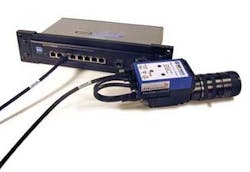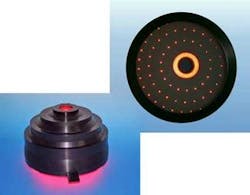TRADE SHOW REVIEW: Lights, cameras, and action highlight Robots & Vision Show
Despite the currently dire economic landscape, exhibitors at the June 2009 International Robots, Vision & Motion Control Show (Rosemont, IL, USA) were pleasantly surprised at the number and quality of the attendees. In the space of three days, more than 4000 visitors managed to visit some of the 140 exhibitors on the floor and attend tutorials and application sessions on robotics, machine vision, and motion control.
Reflecting the vibrancy of the industry, several companies used the show to announce new products targeted firmly toward developers of machine-vision systems. For example, as a first-time exhibitor at the show, Vieworks (Gyeonggi-do, South Korea; www.vieworks.com) displayed a range of high-speed Camera Link and GigE-based megapixel cameras.
Using image sensors from Kodak and Aptina, Vieworks currently offers 15 different cameras ranging from the VH-V264, a 640 × 480-pixel, 264-frame/s Camera Link camera to the VC-4M160C-MC10, a 2352 × 1728-pixel, 160-frame/s Camera Link camera based on an Aptina CMOS imager. According to sales manager Peter Lee, the company is currently looking for distribution in both the United States and Europe.
Like many GigE-based cameras, the GigE cameras offered by Vieworks must be powered over a separate power cable. To reduce the interface to just one cable, Artur Didyk, engineering manager at Components Express Inc. (CEI; Woodridge, IL, USA; www.componentsexpress.com) showed how CEI’s Power over Ethernet Plus (PoE+) adapter could be used to allow non-PoE cameras to operate with a Power over Ethernet switch. “Some systems require more than the 12.95 W supported by the current IEEE 802.3af (PoE) standard,” says Didyk, “but by using the new IEEE 802.3at (PoE+) standard, the BIT MAXX adapter extends the power delivered through Ethernet cables to 24 W, nearly doubling the power that can be delivered to a PoE system.”
“By using the BIT MAXX splitter, system developers can eliminate lengthy power cables, power supplies, and AC outlets they may be using since the BIT MAXX splitter recovers both power and data signals from the attached PoE or PoE+ switch to deliver 12.95 W or 24 W, respectively,” says Ray Berst, president of CEI (see Fig. 1).
Reducing the number of components needed to implement a vision system was also the theme of Latab Elektronik (Vällingby, Sweden; www.latab.se), another first-time exhibitor at the show. Hendrik Schumann, international sales manager, presented an interesting lighting concept the company has dubbed Super Dome (see Fig. 2).
“To accomplish the task of inspecting grinding disks,” says Schumann, “our customer required a light that could read a glossy label on the disk, inspect the surface of the disk for defects, and inspect for the existence of a center clamping ring on the disk.” Unfortunately, there was no space in the production line to build up three control stations; thus, all three tests needed to be performed at one workstation.
To achieve this, Latab’s Super Dome is a combination of three types of illumination: a diffuse domelight to illuminate the glossy label, a darkfield ringlight composed of satellite LEDs that is used for highlighting surface defects, and a ringlight that is used to increase the contrast of the center ring on the disk. “Using just a single multifunctional light allowed a single work-cell inspection system to perform all three tests,” says Schumann.
Although hardware was very much the highlight of the show, one of most interesting demonstrations was the RecogniSense software being demonstrated by Recognition Robotics (Westlake, OH, USA; www.recognitionrobotics.com). Simon Melikian, company president, demonstrated how within a few seconds the software could be used to recognize images somewhat regardless of their size and orientation.
Once recognized, coordinates of the object were then transferred to a robot controller, translated into real-world coordinates, and used by a robotic pick-and-place system. Although Melikian was somewhat reticent to explain the algorithms used to perform this recognition, saying only that they were based on “how the visual cortex of the brain works,” the results were very impressive. According to Melikian, two robotics-based systems that use the software are already in use at Chrysler car body plants.


